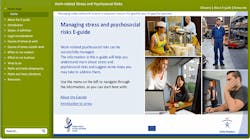Stress at work is the second-most frequently reported work-related health problem in Europe. It accounts for almost half of all lost working days, which costs the European economy 136 billion euros every year due to lost productivity, including sick leave and absenteeism.
In the context of the EU’s current mandate to boost jobs and growth, the Healthy Workplaces Summit 2015 that concluded Nov. 3 in Bilbao, Spain, brought together leading occupational safety and health (OSH) professionals to discuss, network and exchange good practices in managing workplace stress gathered over the course of the campaign.
A key message throughout the campaign has been that stress and psychosocial risks can be assessed and managed in the same systematic way as other workplace risks.
“This is what the partners to the two-year Healthy Workplaces Manages Stress campaign have studied, experimented with and implemented in their workplaces, taking the pulse of their workers through polls and for some, initiating psychosocial risk assessments. They were convinced that the benefits to the business outweigh the costs of implementation and we are proud of the awareness we managed to generate with business leaders,” said Dr. Christa Sedlatschek, director of EU-OSHA.
Data from the recently released ESENER-2 study showed that 53 percent of employers reported having insufficient information on how to include psychosocial risks into their risk assessments, confirming that those risk factors are perceived as more challenging to address than traditional OSH risks. EU-OSHA’s e-guide to managing psychosocial risks provides guidance to small enterprises that are starting to address the issue. The guide is available online in 30 national versions.
Other fundamental topics of the campaign include specific psychosocial risks such as harassment, third-party violence and bullying at work, which contribute to stress in the workplace and can also lead to stress-related health problems as well as negative effects on a company’s performance and business results.
Summit participants include official campaign partners, media partners and national focal points, all of whom have carried out considerable work on the campaign. Summit highlights include political statements, parallel sessions on good practices for managing stress and psychosocial risks, strategies and programs and innovative ways for communicating on OSH. The second day included a panel discussion about how to put research on stress and psychosocial risks into practice.
“We stand by the fact that addressing OSH risk factors in workplaces, including psychosocial risks, stands to benefit the European economy in concrete terms through reduced absenteeism and accident and injury rates and retaining skilled workers, leading to a healthy and productive workforce,” added Nicolas Schmit, minister of Labour, Employment and the Social and Solidarity Economy, representing the Luxembourg EU presidency.
Summit delegates also had a chance to preview the upcoming 2016-2017 Healthy Workplaces for All Ages campaign devoted to promoting a sustainable working life and to raising awareness of the importance of good OSH management at any age and of tailoring work to individual abilities.

